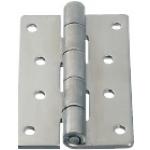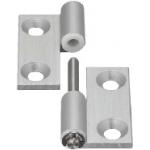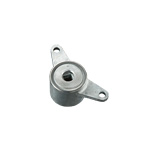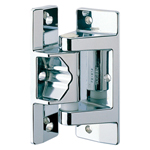(!) Since support from Microsoft will end on January 14 2020, Windows 7 user might not be able to use MISUMI website effectively. Please consider to update your system as ‘MISUMI Website system requirement’.
- แจ้งวันหยุดทำการในเดือน พฤษภาคม 2567 | Notice holiday in May 2024 > คลิก
TAKIGEN Hinges(Main Body Type:Related Components)
TAKIGEN offers products Hinges specified by Main Body Type Related Components from Automation Components product category. There are a total of 1 items. Search and select detailed specifications of parts for your machine with free CAD downloads. TAKIGEN products are available to order through MISUMI online 24 hours a day. Free shipping, no minimum order.
Search by specifying the lower class category
 Flat Hinges
Flat Hinges Detachable Hinges
Detachable Hinges Concealed Hinges
Concealed Hinges Damper Hinges, Spring Hinges
Damper Hinges, Spring Hinges Other Hinges and Nuts for Hinge
Other Hinges and Nuts for Hinge
Configure
Specification/Dimensions
-
Length L(mm)
- 2,000
- 6
- 6.5
- 10
- 17
- 18
- 18.5
- 19
- 20
- 21
- 22
- 23
- 23.5
- 24
- 25
- 25.5
- 25.6
- 26
- 27
- 27.5
- 28
- 29
- 29.2
- 30
- 30.5
- 31
- 31.5
- 32
- 32.25
- 32.5
- 33
- 34
- 34.5
- 35
- 35.5
- 36
- 36.6
- 37
- 38
- 39
- 39.2
- 39.5
- 40
- 40.5
- 40.6
- 41
- 42
- 43
- 43.75
- 44
- 45
- 46
- 47
- 47.4
- 48
- 48.5
- 49
- 49.5
- 50
- 50.5
- 50.65
- 50.8
- 51
- 52
- 53
- 54
- 54.5
- 55
- 56
- 57
- 57.1
- 59
- 60
- 61
- 62
- 62.7
- 63
- 63.4
- 63.5
- 64
- 65
- 65.5
- 65.6
- 66
- 67
- 67.1
- 68
- 68.5
- 69
- 69.5
- 70
- 70.5
- 71
- 71.7
- 72
- 73
- 75
- 75.5
- 76
- 76.5
- 76.7
- 77
- 77.5
- 78
- 79
- 80
- 81
- 81.7
- 82
- 82.6
- 83
- 84
- 85
- 85.3
- 86
- 86.7
- 87
- 87.5
- 88
- 88.9
- 89
- 90
- 92
- 94
- 95
- 95.3
- 96
- 96.5
- 97
- 98.4
- 100
- 101
- 101.2
- 101.5
- 101.6
- 101.7
- 102
- 103
- 104
- 105
- 106
- 107
- 108
- 109
- 110
- 113
- 114
- 114.5
- 115
- 117.5
- 118
- 120
- 121
- 123
- 124
- 124.8
- 125
- 126
- 126.5
- 127
- 130
- 131
- 132
- 132.5
- 133
- 138
- 139
- 139.7
- 140
- 144
- 145
- 148
- 149
- 150
- 151
- 152
- 152.5
- 153
- 154
- 155
- 158
- 160
- 161
- 161.5
- 162
- 167
- 170
- 180
- 183
- 184
- 186
- 186.4
- 190
- 200
- 201
- 204
- 210
- 222.3
- 224
- 225
- 240
- 250
- 258
- 264
- 289.3
- 300
- 340
- 350
- 360
- 400
- 442
- 450
- 476
- 576
- 600
- 626
- 750
- 850
- 900
- 1000
- 1200
- 1800
- 1829
- 1872
- 2000
- 2133
- 2400
- 2500
- -
-
Flat Hinge Type
-
Width W(mm)
-
Body Material
- Stainless Steel
- Steel
- Brass
- Aluminum
- Zinc Alloy
- Resin
-
Main Body Type
-
Operating Environment
- Standard
- Corrosion Resistance
- Abrasion Resistance
- Cleanroom
-
Mounting Method
-
Additional Function
-
Mounting Screw Hole Type
-
Detachable, Flag Hinge Type
-
Main Body Surface Treatment
-
Reversed
Brand |
|
|---|---|
| CAD |
|
- 1 items
- Sort By
-
You can add up to 6 items per a category to the compare list.

Plastic Resin Retaining Cap BP-99-C
TAKIGEN
Cap for retaining precision pivot pins and rods.
[Features]
· Can be installed with single-action.
· Choice of 5 sizes depending on the application.
[Applications]
· Retaining of precision pivot pins and rods.From: ฿ 5.00 Days to Ship: Same day
Same day
| Brand |
|---|
| Product Series |
| CAD |
| From |
| Days to Ship |
| Length L(mm) |
| Flat Hinge Type |
| Width W(mm) |
| Body Material |
| Main Body Type |
| Operating Environment |
| Mounting Method |
| Additional Function |
| Mounting Screw Hole Type |
| Detachable, Flag Hinge Type |
| Main Body Surface Treatment |
| Reversed |
You can add up to 6 items per a category to the compare list. | |
| Brand | TAKIGEN |
| Product Series | |
| CAD |
|
| From | ฿ 5.00 |
| Days to Ship | Same day |
| Length L(mm) | 6 ~ 6.5 |
| Flat Hinge Type | - |
| Width W(mm) | - |
| Body Material | Resin |
| Main Body Type | Related Components |
| Operating Environment | Standard |
| Mounting Method | - |
| Additional Function | - |
| Mounting Screw Hole Type | - |
| Detachable, Flag Hinge Type | - |
| Main Body Surface Treatment | Not Provided |
| Reversed | - |
Loading...
Related Categories to Hinges
-
- Catches
- Door Stays
- Telescopic Slide Rails
- Fasteners, Draw Latches
- Latch Handles, Locks, Keys
- Lighting System
- Gas Springs
- Wires, Chains, Metal Fittings, Small Work Pieces
- Parts, Small Work Pieces
- Hanging Tools
- Extrusion Kits and Mesh Fences
- Knob Screws
- Hanger Hooks
- Shelves, Shelf Supports, Shelf Poles
- Door Wheels
- Handles
- Hinges
- DIY Supplies
FAQ about Hinges
-
- Question: Please explain about the definition of opening/closing angle.
- Answer: Opening angle is 180° where the hinge plates are aligned in horizontally,
Closing angle is 0° where the front surfaces of each plate overlapping. - Question: Please explain about the meaning of Left-hand and Right-hand hinge.
- Answer: Left-hand hinge is a mechanism that hinge fixed at the left-hand side and can be opened or closed at the right-hand side when facing the door.
Right-hand hinge is a mechanism that hinge fixed at the right-hand side and can be opened or closed at the left-hand side when facing the door.
Please select product according to their function. - Question: When using in horizontal direction, is there any change in the allowable load?
- Answer: No change.
- Question: What materials are commonly used for hinges?
- Answer: Common materials used for hinges include:
1. Steel: Known for its strength, durability, and affordability, steel hinges are widely used across various applications.
2. Stainless Steel: Highly resistant to corrosion and staining, stainless steel hinges are commonly used in outdoor or high-humidity settings, as well as in medical or food processing equipment.
3. Aluminum: Lightweight and corrosion-resistant, aluminum hinges are favored for outdoor applications or where weight is a concern, such as on aluminum doors or cabinets.
4. Zinc: Zinc hinges provide a cost-effective option with decent corrosion resistance, often serving as an alternative to brass or steel hinges. - Question: How do I choose the right hinge for my needs?
- Answer: To choose the right hinge for your needs, consider the following factors:
1. Environment: Choose a hinge suitable for the environment it will be placed in, such as indoor or outdoor use
2. Type: Select the appropriate hinge type based on your application, such as Continuous Hinges, Butt hinge, Concealed Hinges and so on
3. Size: Ensure the hinge is the correct size for the objects you want to connect, considering width, height, and length
4. Strength: Choose a hinge with sufficient strength to support the weight of the objects it will connect
5. Finish: Select a hinge finish that matches the appearance of your cabinets or doors, or choose a bold finish to draw attention
6. Material: Choose a hinge material that is suitable for your environment and application, such as stainless steel for outdoor use or brass for decorative purposes
7. Fastener holes: Consider the number of fastener holes and their location when choosing a hinge - Question: Are there any hinges suitable for heavy loads or special environments?
- Answer: Yes, there are hinges suitable for heavy loads or special environments. Heavy-duty hinges are designed to withstand substantial loads and frequent use, making them ideal for industrial and commercial. These hinges are available in various types, including continuous hinges, concealed hinges, and Torque Hinges. They are typically made from robust materials such as steel and stainless steel, often featuring protective coatings or materials that make them suitable for outdoor or harsh environments.
- Question: How do I install different types of hinges?
- Answer: Installing different types of hinges can vary depending on the type of hinge and the application. However, there are some general steps that can be followed.
1. Determine the type of hinge needed for the application. Common types of hinges include Continuous Hinges, Butt hinge,Concealed Hinges
2. Determine the placement of the hinge on the door or cabinet.
3. Drill holes for the screws using a Vix bit or a specialty bit that drills holes centered on a hinge's mounting holes.
4. Insert screws into the holes and tighten them.
5. Test the hinge to ensure it is properly installed and functioning correctly. - Question: What should I consider for hinge maintenance?
- Answer: To maintain hinges effectively, consider the following guidelines:
1. Lubrication: Apply light oil or silicone spray to non-self-lubricating hinges to prolong their lifespan.
2. Cleaning: Wipe off excess oil to prevent dirt buildup on hinges.
3. Tighten Screws: Regularly check and tighten loose screws, adding more if necessary for added support.
4. Check Alignment: Ensure hinges are aligned correctly and doors/gates are not sagging or misaligned.
5. Protection: Use weather-resistant materials for outdoor hinges to prevent rust and corrosion.
6. Regular Inspections: Periodically inspect hinges for signs of wear, damage, or misalignment.
7. Replace Worn Parts: Replace any worn or damaged components to maintain functionality and durability.









































How can we improve?
How can we improve?